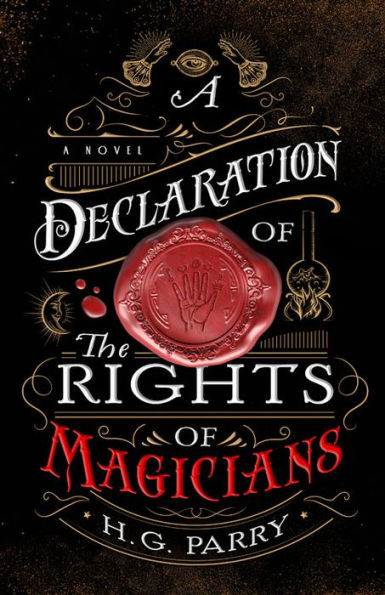H.G. Parry’s A Declaration of the Rights of Magicians is an epic historical fantasy, a magic-imbued retelling of the political and social turmoil that took place in late 18th-century Europe as well as the French colony Saint Domingue (currently the sovereign state of Haiti). Those who know their history will recognize that this is the time of the French Revolution (AKA the Reign of Terror) as well as the Haitian Revolution, a slave uprising that created an independent Haiti, a state free of slavery and led by the land’s former captives.
The novel, like this time period, is epic in scope, and Parry does an exemplary job portraying these world-changing upheavals in Europe and Haiti through the book’s (and, in most cases, history’s) major players. Two of the points-of-view in the novel, for example, are Maximilien Robespierre and William Pitt, who history buffs will respectively recognize as a leader of the French Revolution and as the Prime Minister of Britain. Other key characters include William Wilberforce, a real-life historical figure who strongly pushed for the abolishment of slavery in the British Empire, and Fina, a young West African woman who British slave traders captured and shipped to what is now the island of Jamaica.
A Declaration of the Rights of Magicians isn’t just historical fiction, however, even though it appears to stay mostly true to the known occurrences of the time. Interwoven between the events outlined in our school textbooks is Parry’s creation of a magical system that seamlessly plays an integral part in the political and social movements of the time. In this fantastical timeline, magical capabilities are a hereditary trait that can show up across family lines no matter what social class one may have. In Europe, however, the right to actually practice magic is kept to the aristocracy; those commoners identified by the Knights Templar as having magical powers at birth are shackled with a bracelet that limits their magical abilities, and any commoner found guilty of using magic—even to save the life of a loved one—is sentenced to jail or even death.
Buy the Book


A Declaration of the Rights of Magicians
This means that the Marie Antoinette in this world is a powerful fire mage, and that the charismatic Robespierre has some latent magical tendencies toward mesmerism and an even rarer magical bloodline. The impact of magic is also seen in the practice of slavery, where slave traders force-feed captured Africans a magical brew that makes them living zombies, unable to move or even speak on their own volition.
The magic system Parry creates here is a rich one, and it’s clear that the author put a lot of thought into how the societies and institutions of the time would react to and try to control hereditary elemental magic among the populace. The presence of magic also allows Parry to create a sinister magical mastermind who is pulling the strings behind the horrors of the time. It is this secret malevolent force—who they may be what and what they may want—that drives much of the plot of the novel. And while the whodunit provides some propulsion to the story, it’s hard, especially in our current times, to gloss over the fact that humanity doesn’t need the excuse of a malicious supernatural being to explain why so many unjust and evil elements existed and continue to exist in society.
This is most obvious in Fina’s storyline, which regrettably doesn’t get as much page time as the other characters. Given this is the first in a duology, however, I anticipate Fina and her part in the Haitian Revolution to get more attention in the second book. In A Declaration of the Rights of Magicians, however, Fina realizes she is able to overcome the zombifying brew and regain autonomy, which ultimately lets her escape to Haiti where the slave uprising there is in full swing.
In Haiti, she’s allowed to cultivate her magical capabilities instead of suppressing them (unsurprisingly, the British and the French would summarily kill any enslaved person found to have magical powers), and she ends up aiding the real-life historical leader of the uprising, Toussaint Louverture, who in this alternative history also has some minimal magic ability to control the weather. In Haiti, Fina also becomes more confident—clearer on who she is and what ends she thinks may justify the means. Where her journey takes her remains to be seen, but it is her journey I’m most interested in learning more about in the second book.
A Declaration of the Rights of Magicians ends on somewhat of a cliffhanger, though I suppose those who know history already know at least the broad strokes of the second book’s plot. But the main thing that will have me picking up the net installment in this duology isn’t the retelling of how that time period plays out—it’s the characters Parry has beautifully brought to life in this magical alternative timeline. As I mentioned earlier, I’m particularly interested in spending more time with Fina, but I also care about Pitt and Wilberforce, two real-life figures that Parry crafts into three-dimensional individuals, recognizable from our history texts but different in this magic-touched world. It’s Parry’s deft crafting of these characters’ personal struggles that make the larger events around them have more poignancy, and it’s Parry’s detailed and expansive worldbuilding that make A Declaration of the Rights of Magicians an immersive read and a world I look forward to revisiting when the second novel comes out.
A Declaration of the Rights of Magicians is available from Redhook.
Vanessa Armstrong is a writer with bylines at The LA Times, SYFY WIRE, StarTrek.com and other publications. She lives in Los Angeles with her dog Penny and her husband Jon, and she loves books more than most things. You can find more of her work on her website or follow her on Twitter @vfarmstrong.










